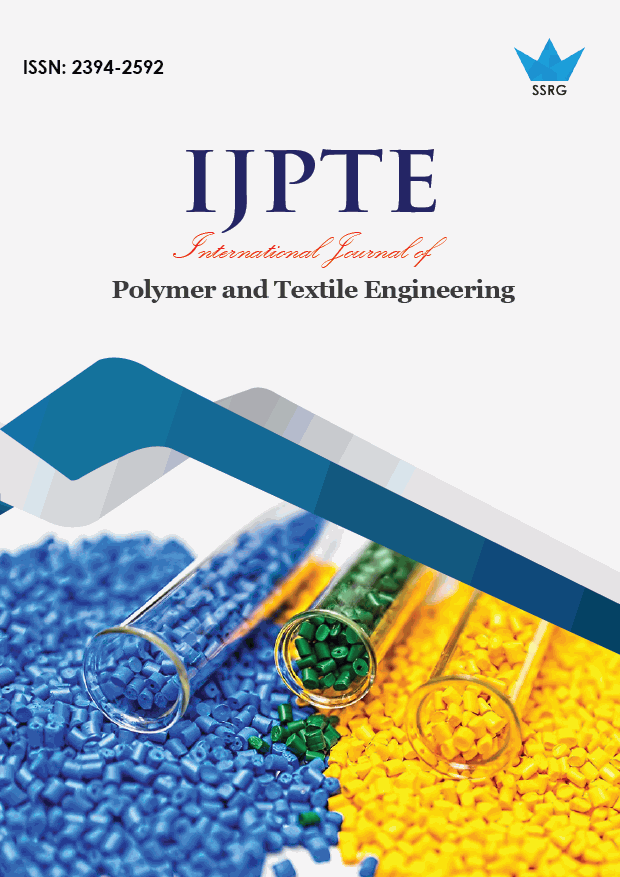Mechanical Properties of High Density Polyethylene and Linear Low Density Polyethylene Blend

| International Journal of Polymer and Textile Engineering |
| © 2020 by SSRG - IJPTE Journal |
| Volume 7 Issue 1 |
| Year of Publication : 2020 |
| Authors : NWAPA, C., OKUNWAYE, O. J., OKONKWO, C. L.& CHIMEZIE, O. W |
How to Cite?
NWAPA, C., OKUNWAYE, O. J., OKONKWO, C. L.& CHIMEZIE, O. W, "Mechanical Properties of High Density Polyethylene and Linear Low Density Polyethylene Blend," SSRG International Journal of Polymer and Textile Engineering, vol. 7, no. 1, pp. 23-28, 2020. Crossref, https://doi.org/10.14445/23942592/IJPTE-V7I1P103
Abstract:
This work investigated the mechanical properties of high density polyethylene (HDPE) and linear low density polyethylene (LLDPE) blend at various ratios (95 % HDPE & 5 % LLDPE, 85 % HDPE & 15 % LLDPE, 75 % HDPE & 25 % LLDPE, 65 % HDPE & 35 % LLDPE and 55 % HDPE & 45 % LLDPE). Specimen 1 (100% HDPE) was used as the control. This blend would be used in the production of plastic buckets (twenty and four litres) for packaging of chemicals and paints. It was found that specimen 4 (75 % HDPE & 25 % LLDPE) had 6.72 % rise in modulus of elasticity, 31.50 % rise in elongation at break and 7.59 % rise in impact resistance. While specimen 5 (65 % HDPE & 35 % LLDPE) had 17.52 % rise in abrasion resistance, 12.58 % rise in hardness and 10.87 % rise in flexural strength.
Keywords:
Blending of HDPE & LLDPE, Mechanical properties of HDPE & LLDPE .
References:
[1] Arends, C. B. (1996). Polymer Toughening. Marcel Dekker, Inc. New York. USA. Pp: 189 – 235.
[2] Bhateja, S. K. and Andrews, E. H.(1983), Polymer Engineering Science.RCS Publishing London. Pp: 23, 888.
[3] Carraher Jr., C. E. (2010). Introduction to Polymer Chemistry. Second Edition. CRC Press Taylor and Francis Group London. Pp: 196 – 201
[4] Edward, L. P., Atiemo-Obeng V.; Kresta, S. M.(2003). Handbook of Industrial Mixing: Science and Practice. John Wiley & Sons London. Pp: 100 – 136.
[5] Han, C. D. (1981). Multiple Flow in Polymer Processing. Academic Press New York. Pp: 100
[6] Harper, C. A. (2000). Modern Plastics Handbook. McGraw- Hill Companies, Inc. New York, USA. Pp: 1.83 – 1.84
[7] Kulshreshtha, A. K.(2002). Handbook of polymer blends and composites. Volume 1. Smithers Rapra Publishing. Pp: 250
[8] McCrum, N. G., Buckley, C. P. and Bucknail, C. B.(1997). Principles of Polymer Engineering. Oxford University Press, Oxford, New York. Pp: 1.
[9] Olabisi, O., Poberson, L. M. and Shaw, M. T.(1979). Polymer-Polymer Miscibility, Academic Press, New York. Pp: 350.
[10] Olatunji, O. (2005). Natural Polymers: Introduction to Physical Polymer Science. John Wiley & Sons London. Pp: 250.
[11] Osswald, T., Lih-Sheng T. and Gramamn P. J.(2007). Injection Moulding Handbook. Second Edition. Hanser Veriag Publishers. Pp: 250.
[12] Paul, D. R. and Newman, S. (1978). Polymer Blends. Academic Press. New York. USA. Pp: 76 – 81.
[13] Paul, D. R., Winson, C. E. and Locke, C. E. (1972). Polymer Engineering Science. RCS Publishers London. Pp: 13, 157
[14] Peacock, A. J.(2000). Handbook of Polyethylene: Structures, Properties and Applications. Marcel Dekker Inc. New York, USA. Pp: 55 – 150.
[15] Progelhof R. C. and Throne J. I. (1993). Polymer Engineering Principles: Properties, Processes, and Tests for Design. Hanser Publishers. New York, USA. Pp: 33 – 41
[16] Rana, S. K. (2002). Blend of High Density Polyethylene and a linear low-Density polyethylene with Compositional- Invariant Mechanical Properties. Journal of Applied Polymer Science, Volume 83, 2604 – 2608.
[17] Rosato, D., Rosato M. and Rosato D.(2000). Injection Moulding Handbook. Third Edition. Kluwer Academic Pulishers. New York, USA.
[18] Shebani, A., Klash, A., Elhabishi, R., Abdsalam, S., Elbreki, H. and Elhrari, W. (2018). The Influence of LDPE Content on the Mechanical Properties of HDPE/LDPE Blends. Research and Development in Material Science. Volume 7, Issue 5, 791 – 797.
[19] Zhou, Z., Lu, X. and Brown, N. (1993). The effect of blending high-density and linear low-density polyethylenes on slow crack growth. Butterworth-Heinemann Limited. Volume 34, Number 12.

 10.14445/23942592/IJPTE-V7I1P103
10.14445/23942592/IJPTE-V7I1P103